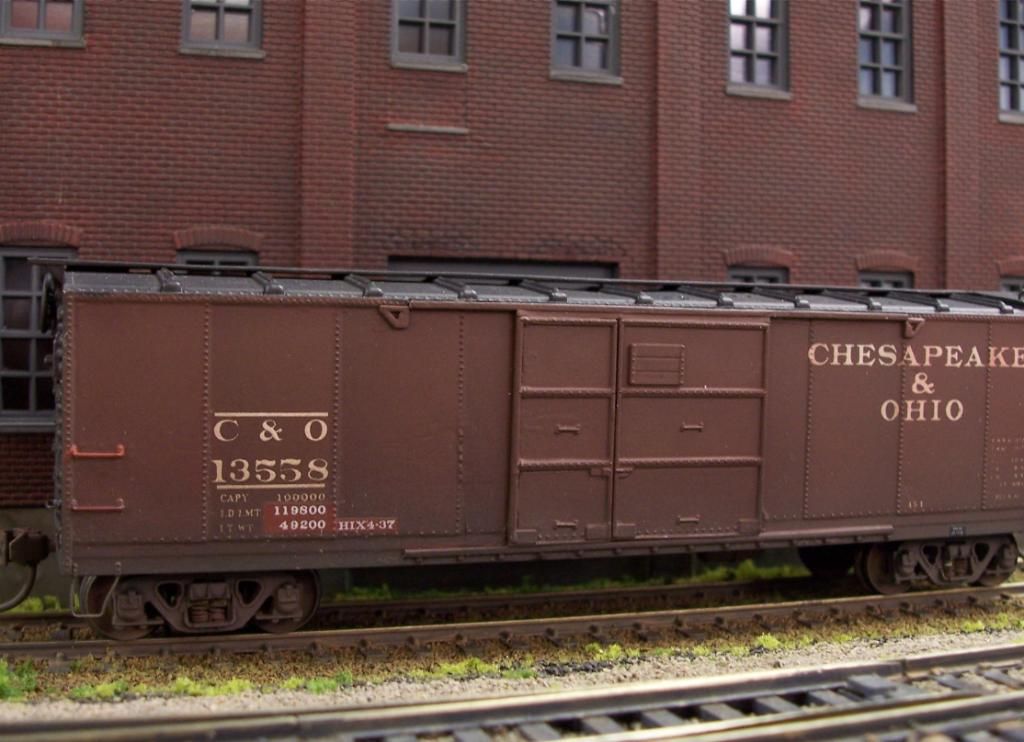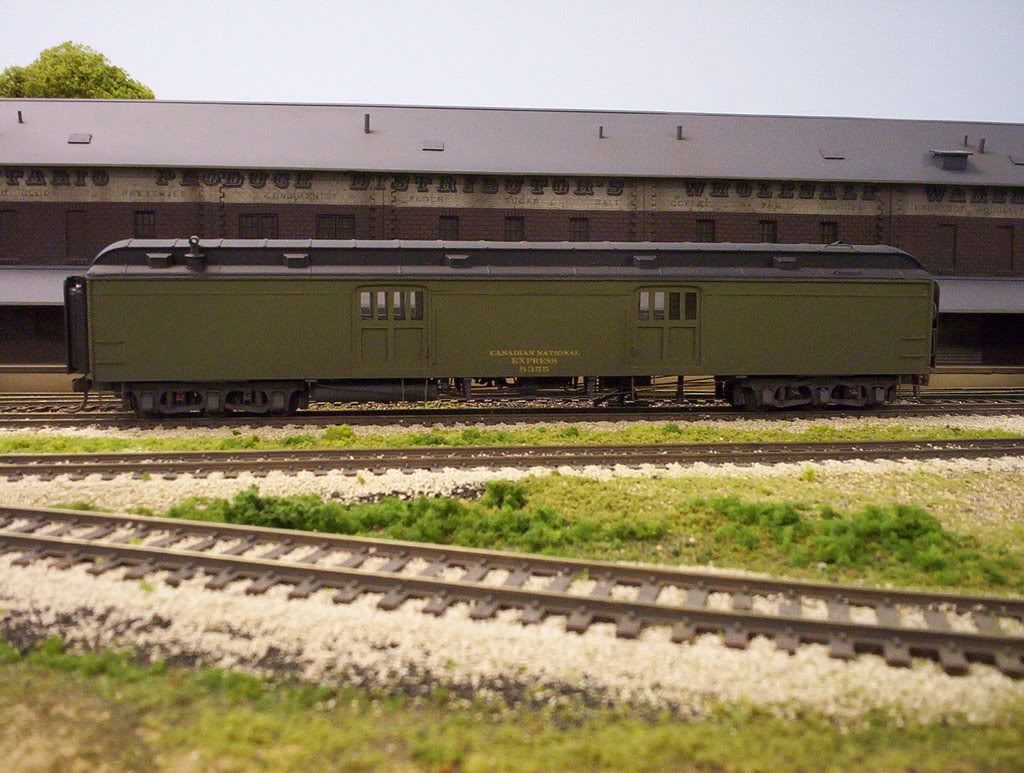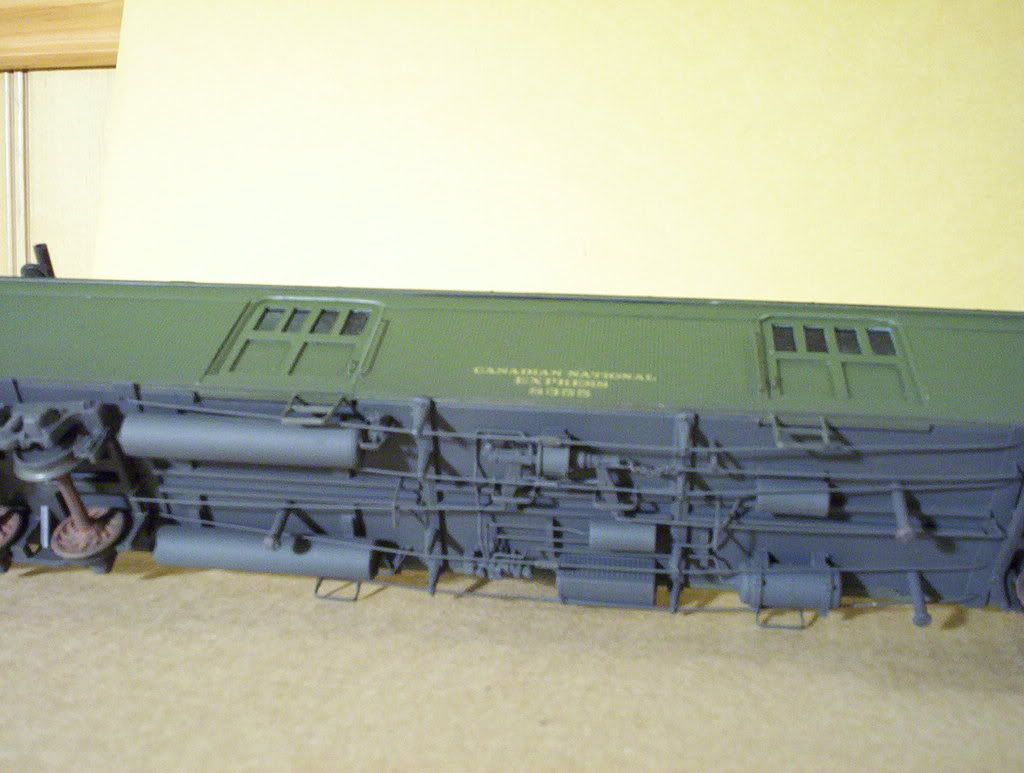I purchased a Rivarossi NYC RPO at a train show a while back. I just now got it out to do various upgrades and discovered it is missing the exterior details (mail catcher, door bars, etc). Is this available as a seperate kit? I struck out looking on ebay but maybe I wasn’t using the correct search argument. I went to the Hornby website but every time I clicked on Rivarossi, it took me to their UK website. If I can’t locate a kit, I’ll probably have to buy a used RPO on ebay just for the parts.
I have two or three of those Rivarossi RPOs, but as I recall, only one or two of them came with a mail catcher. It looked overly clunky to me, so I simply tossed it, as I don’t model pick-up-on-the-fly.
If you want them, I’d guess that if you had a decent photo of a real one, you could probably replicate it using suitably-sized phosphor-bronze wire from Tichy.
The only one that I have with a mail catcher was on an unpainted Walthers car, a model of a Pennsy prototype.
While I do have a couple of Pennsy head-end cars, I modified the Walther’s car by changing the porthole type windows in the doors to square ones, then lettered it for one of my freelanced roads…(the photos will enlarge if clicked-upon)
(…and looking at the photo, I realised that I’d forgotten to add grabirons above the scratchbuilt stirrup steps near the car’s ends.)
This one’s a Rivarossi car, but I modified it somewhat with built-up stirrup steps, a couple of windows in the baggage compartment (cut from Athearn coaches), along with some extra grabirons and some scratchbuilt window bars for the postal section…
This one’s similar, but without the baggage windows or the bars in the postal-area windows.
This one is a shortened Athearn postal car…
I have only another three postal cars to scratchbuild. All three will be identical models of an early CNR prototype…one each for a couple of friends, and one for me.
The one I have has the holes drilled for both the bar and the mail catcher so I can’t just leave that detail off. When I bought it, I could see the holes through the front of the box and I made the mistake of assuming the hardware was included. The fact that these details are a bit clunky is less of a concern to me. You obviously spend a lot of time detailing your models and I can understand why that would be important to you but I have more of the good-enough approach to the detailing. I might have to keep an eye on ebay to find one with all the detail. I’ll probably have to spend well over $20 to get one with all the hardware. I could check Walthers to see if that have a mail catcher that will cover the holes.
Hi John,
Bowser’s CalScale parts brand has a mail catcher part# 190-345 that I bet only costs a few bucks. May be a better option than waiting for another RPO to show up.
Scott Sonntag
Thanks. It costs $7.70 but that’s for a package of two which is needed for both sides of the car. It’s also in stock. That will be cheaper than buying a whole car on ebay if and when one becomes available.
I just noticed on the box that this RPO was part of the IHC Premier series. Apparently that was a run of upgraded Rivarossi passenger cars. In addition to the holes for the mail catcher and the door bar, there are holes for the stirrups.
It’s very easy to get rid of small cast-in-place holes in plastic models. All you need is some Evergreen styrene rod with a diameter just slightly larger than that of the hole.
Use a small brush to apply a little liquid cement for styrene to both the inside of the hole, and also to the outer surface of the rod. While both are still wet, jam the rod into the hole, then let the joint fully harden. You can then use a #17 chisel-type blade to snick-off the rod and smooth the surface.
I keep a good supply of styrene rod, in all available sizes, as it’s useful for a lot of scratchbuilding projects.
If you don’t need to have a similar stock of the various sizes, you could decide on one of the larger diameters, then purchase a drill bit just a little smaller than the diameter of that rod.
This will allow you to re-drill any holes that you wish to plug, then use the describe process to plug them, using the larger rod.
I’m not familiar with the Cal-Scale mail catcher, but their products are usually scaled properly, so I’d guess them to be better than the ones that didn’t come with your postal car.
I do think, though, that you could easily fabric decent replicas using brass or phosphor-bronze wire: simply draw or copy a to-scale representation, then use it as a pattern on which to form the wire. A small pair of needlenose pliers would be useful for doing the forming.
Wayne
I found a matching RPO on ebay and I contacted the seller to confirm it still had its hardware. It has cost me about $37 with shipping and tax but I figured it was probably my best chance to get all the parts needed to fill the holes.
Filling the holes would have been just part of the problem. I would also have needed to match the paint and if not done well, it would be almost as bad as not filling the holes at all.
I don’t like having to pay that much just to get parts but the value of something is often dictated by how rare it is and I didn’t see any better options. I was afraid if I didn’t snatch this one when I had the chance, I might regret it. I can try to resell the Southern Crescent RPO as-is or repaint it Pullman Green after filling the holes. I could then letter it for my fictional railroad. I can always use another RPO for that.
John’
Mismatched paint on prototype equipment is not as rare as you would believe. Components are always being replaced, and repairs being made. Touchups-if there are any-very seldom match the original color, due to age and weather. RPOs that snagged mail on the fly usually had stainless steel plates in the vicinity of the hook (Pennsy for one), or whenever the car side really looked battered, those areas were touched up. Hooks also got pranged and were replaced. To me, that makes the car look like it actually served its purpose, instead of appearing like a model of a pristine RPO. Besides $37 is kind of steep for what at the most is two dollars worth of parts.
That’s a very good point, and also a good way to add some “history” to your rolling stock.
I’ve changed-out a lot of cast-on grabirons and handrails, and replaced them with metal ones. Because my rolling stock cycles on- and off-layout, periodically returning to their respective boxes, I often find those details missing some paint. It’s easy to simply grab a bottle of paint that’s similar to the original colour, but definitely not a match.
This is a good way to show that your rolling stock has visited the rails of other railroads, where perhaps that car had a minor sideswipe, requiring that road to make a repair. Here’s an example…(click on photos for a larger image)

The re-weigh and re-pack regulations play a similar role, and if your road’s boxcar shows up on the rails of another road, due for re-weigh and/or re-pack, that road was liable to do the required work.
This was part of an agreement between all North American railroads, were there were fixed rates for all sorts of repairs and upkeep work. At the end of every month, each railroad would send out invoices to the owner roads for whom they had done such work. This agreement helped to ensure that cars in good repair would always be available, rather than being returned to their home roads for such work. A car with a missing grabiron or a broken sill step was required to be repaired by the road on which the defect was found.
As for re-weigh and re-pack, each road was similarly responsible, and the changed data showed the date and place where those operations were performed…
Yes, it is steep but it’s already done. A touch up here or there migh be acceptable but there are about a dozen holes on each side that would have to be filled and painted. I can’t see making a convincing case for all those touch ups. In another thread I inquired if RPOs would continue on to foreign rails on a joint passenger train and the answers I got indicated they stayed on home rails so trying to explain it away as a sideswipe on foreign rails doesn’t seem plausible, especially if there would have been so many.
It’s not a complete write off. Rather than resell the unused RPO, I can fill the holes and repaint the entire thing in Pullman Green. I have found that Tamiya’s Air Force Green is a very close match to most of the RTR heavyweight equipment being sold as Pullman Green livery. I had some Scalecoat Pullman Green which is much darker that what the manufacturers make and looks almost black in artificial light. As long as the repainted RPO fits in with the rest of the fleet, I’m OK with it not being a true Pullman Green. I have plenty of left over decals for it as well. I run lots of passenger trains so adding another RPO for my home road is beneficial.
Dr.Wayne
I always admire your rolling stock–especially your passenger cars. Do you add/upgrade detail to the underbody of your Rivarossi or Athearn passenger cars? If so, where do you obtain appropriate detail parts? What sources do you use to learn proper placement of such details?
Cheers,
David
Hi David, and welcome to the MR Forums.
I do add underbody details to most of my passenger cars and almost all of my freight cars, too.
Some of the details for passenger cars come from many no-longer-in-business sources, often picked-up at train shows or back when there were nearby hobbyshops, that still carried out-of-production detail parts.
For much of what I use, I don’t even know the name of the company who produced the parts.
In the past, New England Rail Services offered some very nicely-done plastic parts, but I haven’t seen them for quite some time.
One good source for detail parts is Cal-Scale, which is part of Bowser.
In addition to that, Bowser also carries detail parts from other sources, some of which were absorbed into Bowser. I don’t have a specific link for those, but you can contact them at English’s Model Railroad Supply.
Another good source of detail parts, in both brass and plastic, is Precision Scale Co., Inc.
A few photos (click on the pictures for a larger view)…
This one started out as an Athearn coach…


I removed the car’s sides, but kept the roof and ends as one piece. I also removed most of the cast-on details from the underbody. I used Evergreen vertical “wood” siding for the new sides and scratchbuilt the baggage doors from styrene.
I then added truss rods and Pintsch Gas tanks (made from styren
thank you for the informative post, Wayne. I was wondering how you learned about the functions of all the “stuff” underneath passenger cars. Looks like I need to track down some Mainline Modeler back issues!
Best,
David
I’m in the process of moving the handrails from an older and less valuable model to improve/repair a newer and more valuable model. Once done I’ll sell the older model for whatever. Somebody may havevthe patie to build new handrails for the older model, or even run it without. It’s a Proto 2000 which is s pretty good locomotive.
For passenger car improvements to get what you want just buy another not so good version, take off what you need and sell the remaining “core” to someone who wants it, or thinks they do.
No, that’s a common misconception, possibly caused by the Italian-made Rivarossi cars being imported into the US by a company with a similar name - AHM - starting in the 1960s. But IHC cars are not Rivarossi cars, they are different and (IMHO) inferior to the old Rivarossi / AHM cars. IHC quit producing their line some time back; there is still a website but not sure how up-to-date or active it currently is…
IHC cars are not considered particularly great compared to more recent cars from Walthers, Atlas, etc. and aren’t all that expensive. A search on ebay or a railroad flea market will often find them selling in the $10-15 range, so if you did buy one just for the parts it wouldn’t be that big a cost. If yours doesn’t have an interior, separate interior kits for them were available from IHC at least at one time.
BTW the Rivarossi name has changed hands several times over the last couple of decades, with Walthers and later Hornby owning it. About 20 years ago, a line of 60’ HO passenger cars were made under the Rivarossi name, these are nice but unfortunately also get confused with the old Rivarossi cars from the 1960’s-1990’s.
The IHC cars might not have been produced by the Rivarossi company but they are clearly the same car. I have an old heavyweight Union Pacific RPO stamped with the Rivarossi logo and it is nearly identical to the IHC RPO. The underside is exactly the same except that the Rivarossi logo is missing from the IHC car. The bodys of the car are the same except the IHC car has louvred windows and holes for adding details such as mail catchers, stirrups, and grab irons. There is no question the IHC cars are made from the same molds with minor modifications. It is not uncommon at all in this hobby for the same item to have been produced by multiple companies. I’ve seen it with plastic structures and is clearly the case with the IHC passenger cars.
I bought a fair number of IHC cars in the 1990s and were very disappointed with them, and began buying the Rivarossi / AHM cars instead. If you really compare the cars, they’re clearly not the same. The biggest tip-off that they’re different is that the IHC interior kits don’t work in Rivarossi cars. The interior floor supports and such are different, so the openings in the IHC interior kit floors aren’t in the right place if you try to put them in a Rivarossi car. If you modify an interior so it will fit inside, you find the windows in the Rivarossi cars don’t line up with the interior walls and seats of the IHC interiors. The Rivarossi cars had fairly well done cast-on handrails and grabs, the IHC car sides are smooth except for holes for rather clunky, oversided handrails to be added. I found the IHC trucks and overall ride to be inferior to the old Rivarossi cars too.
Whoever created the IHC cars may have intentionally made them to look kinda like Rivarossi cars, but in my experience they’re more just a cheap ‘knock off’ version.
Yes when one company ceases production, they often sell their molds to another company, so the same kit over the years may be sold under multiple names. But not at the same time! IHC started making their cars while Rivarossi cars were still in production. Unlikely Rivarossi worked out a deal to sell their molds to IHC so IHC could make cheaper/inferior versions of Rivarossi cars to compete with Rivarossi’s own product.
I don’t find it at all hard to believe that Rivarossi would outsource the production of their cars to IHC. I don’t know what the arrangement between these two companies was but looking at the two RPOs, it is impossible for me to believe the didn’t come from the same original mold. I don’t know enough about the manufacturing process to know if it is possible to duplicate a mold and what it would take to make minor modifications but these two cars had to have been made either by the same mold or a copy of the original mold.
Below I’ve posted pictures of the two cars. The IHC car is the top one in both photos. The first shows the undersides.

The only difference is that the IHC used a shinier plastic and they eliminated the Rivarossi logo. Other than that they are identical to the tiniest detail, even some that are too fine to show up in he photo.
Here are the car bodies.
_Postal_car.JPG)
_Postal_car.JPG)

